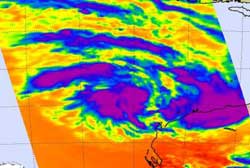NASA Satellite sees two 'tropical fists' threatening Australia

On Feb. 15 at 06:17 UTC (1:17 a.m. EST) AIRS instrument infrared data showed three areas of strong convection (purple) in System 97S. There are three areas of strong thunderstorms and convection (purple) where cloud top temperatures were so high in the atmosphere that they were as cold as or colder than -52 Celsius/-63 Fahrenheit. Credit: NASA JPL, Ed Olsen<br>
System 97S was located about 210 nautical miles north-northwest of Learmonth, Western Australia, at 1800 UTC (1 p.m. EST), Feb. 15. It was centered near 19.2 South and 112.1 East. That puts the center of System 97S well to the northwest of Exmouth. System 97S is forecast to move west or southwest over the next few days.
NASA's Atmospheric Infrared Sounder (AIRS) instrument captured infrared satellite data of System 97S on Feb. 15 at 06:17 UTC (1:17 a.m. EST). AIRS flies onboard NASA's Aqua satellite and the data showed three areas of strong convection in the low pressure area. Those areas of convection appear to be consolidating. Water vapor imagery confirmed that System 97S has rapidly consolidated in the 12 hours before and showed banding of thunderstorms around the southern edge of the center of circulation.
Maximum sustained winds are estimated between 20-25 knots (23 to 29 mph/37 to 46 kmh) and minimum sea level pressure at 1003 millibars.
A Cyclone Watch has been declared for coastal areas from Onslow to Coral Bay. Strong Wind Warnings are in effect from Wallal to Barrow Island, Barrow Island to Northwest Cape, and Northwest Cape to Coral Bay.
The Joint Typhoon Warning Center gives System 97S a good chance of becoming a tropical depression in the next 24 hours. Forecasts currently keep System 97S away from land over the next three days.
For more information about System 99S, visit: www.nasa.gov/hurricane.
Media Contact
All latest news from the category: Earth Sciences
Earth Sciences (also referred to as Geosciences), which deals with basic issues surrounding our planet, plays a vital role in the area of energy and raw materials supply.
Earth Sciences comprises subjects such as geology, geography, geological informatics, paleontology, mineralogy, petrography, crystallography, geophysics, geodesy, glaciology, cartography, photogrammetry, meteorology and seismology, early-warning systems, earthquake research and polar research.
Newest articles

A universal framework for spatial biology
SpatialData is a freely accessible tool to unify and integrate data from different omics technologies accounting for spatial information, which can provide holistic insights into health and disease. Biological processes…

How complex biological processes arise
A $20 million grant from the U.S. National Science Foundation (NSF) will support the establishment and operation of the National Synthesis Center for Emergence in the Molecular and Cellular Sciences (NCEMS) at…

Airborne single-photon lidar system achieves high-resolution 3D imaging
Compact, low-power system opens doors for photon-efficient drone and satellite-based environmental monitoring and mapping. Researchers have developed a compact and lightweight single-photon airborne lidar system that can acquire high-resolution 3D…





















